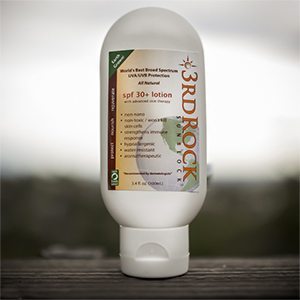Did you know that you can get burned even when it is cloudy or snowing? The sun's UV rays are constantly on the prowl for skin to damage.
While the best sunburn prevention method is to remove yourself from the sun, it is not always a plausible option. Natives have been getting by for centuries with sun block methods and remedies that nature has to offer. We've gathered a few for you to try, whether you are surviving the wilderness or looking to save a little pocket change:
But first, check out this great deal on natural sunscreen we hunted down just for you:
Save 15% at HoneyColony.com when you pre-order this summer's hottest sunscreen: 3rd Rock Sunblock!
Natural Sunscreen for Survival
The Mud Bath

If we take a second and watch nature take its course, we'll learn a thing or two about primitive survival. Animals, like the elephant, and many tribes have been using this trick for centuries to combat a sunburn. Mud acts as a physical barrier between your skin and the sun by blocking the sun’s UV rays. When the mud eventually dries out and cracks off, it leaves behind a residue that also blocks UV rays.
Aspen Trees

Aspen trees are native to cooler regions in the Northern Hemisphere, like around Colorado and Utah. The white powder found on the trunks has an SPF of 5, which can serve as a sun block. Use your hands to remove the powder from the tree and rub over exposed parts of your skin. Since the SPF is low, this powder will need to be reapplied frequently. The good news is, you can scrape off the powder and save it to use later.
If you are in a cool region searching for an Aspen tree, look for a tree with a white trunk and little round-ish leaves that seem to sparkle in the wind.
Tomato

Lycopene, a carotenoid found in tomatoes, is known to protect against sun damage. Cooked tomatoes, and tomato products like paste and sauce are more viable to prevent sun damage than raw tomatoes, although both can get the job done. Add about 3 tablespoons of tomato paste to your daily diet to build up your immunity against future sun damage.
Vitamin D

Ironic, right? The sun is the most common source of vitamin D, yet we need more of it to build a tolerance against it. You can also supplement Vitamin D into your diet with pill vitamins, tuna, egg yolks and oranges.
Burn Remedies
Aloe Vera
We figured we would go ahead and knock this baby off our list. The Aloe Vera plant is the most common natural burn remedy as it offers a cool, soothing feeling on the burned skin. Simply break open a stem to find the gel-like substance and apply to the burn.
This succulent plant can be found in Florida, Arizona and Texas.
Witch Hazel

Witch hazel is a shrub or small tree that contains the compound Tannin, which is known to reduce inflammation. Press the oil out of the witch hazel leaves and apply.
This plant grows sporadically throughout North America. It can be found in eastern North America, from Nova Scotia west through Minnesota, as well as from south Florida and west through East Texas. It may also be found around Oklahoma, Arkansas and Missouri. It can typically be found between the months of January-March and September-November.
Jewelweed

This is a common wild plant in North America, and can be found along moist areas, shady areas such as creek banks. These weeds tend to grow around five feet tall, with blue-ish green leaves and yellow-orange buds.
Similar to Aloe, you'll want to use the jelly-like juice from the inside of the stems.
Peppermint

Peppermint is a perennial plant that can grow just about anywhere if it has plenty of moist soil. However, if you are looking for it in the wild, it can be found in the Great Lakes region.
Apply cool peppermint tea to the skin or grind fresh leaves and make a paste to sooth itchy, irritated skin. Freeze the tea in the summertime to make peppermint ice cubes – your burns will love it.
Chickweed

This plant is common in North America and can be found in fields. Look for a light-green weed with small white flowers. Similar to Witch Hazel, it also contains Tannins that can relieve skin irritation. Simply create a paste with the leaves to use as an ailment.
Plantain

This plant probably pops up in your yard when you let it get a tad overgrown, and you didn't even realize it. They are wind-pollinated, so they grow quite wildly. The leaves contain a anti-inflammatory compound, perfect for burns.
To soothe your skin, chew up a few leaves and cover the burn for at least 15 minutes.


Leave a Reply